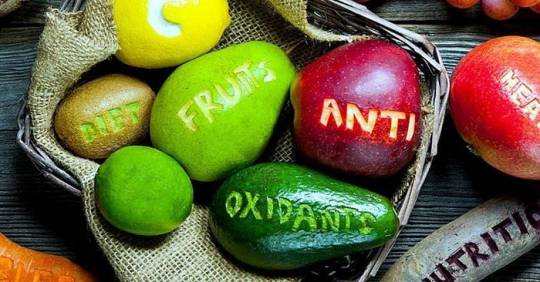Text
Antioxidants: Benefits and How to Get More

Most people know that antioxidants are really good for us, but they don’t really understand why. I’m going to share with you why they are important and how you can get more of them in your diet.
What are Antioxidants? Why are they important?
You can think of antioxidants like little bodyguards to protect your cells from damage that can lead to premature aging and disease. You body’s cells face threats every day. These threats can be from infections, viruses, or free radicals.
Free radicals are a word you will often hear when talking about antioxidants. They are natural or man-made elements and can be:
Environmental toxins, like tobacco, alcohol, and pollution
Ultraviolet rays from the sun or tanning beds
Substances found in processed foods.
Free radicals can attack healthy cells in our body. Some cells are able to heal from this damage, while others can not. Cell damage caused by free radicals appears to be a major contributor to aging and diseases such as:
Cancer
Heart disease
Diabetes
Decline in brain function
Decline in immune function
Our body has a built-in defense to fight and reduce free radicals and the damage they cause, but it could use some help. You can help by protecting your skin from sun exposure, stop smoking and eating healthy. Antioxidants can help too.
Antioxidants are compounds that help protect and reverse some of the damage caused by free radicals. Your body uses antioxidants to balance these radicals out and keeps them from potentially damaging parts of your cells.
Common Antioxidants
Antioxidants are produced in the body and also found in certain foods. Each antioxidant has a different chemical make-up and provides different health benefits. Common antioxidants include:
Vitamin A: Milk, butter, eggs, and liver
Vitamin C: Most fruits and vegetables. Especially fruits such as berries, oranges, kiwis, cantaloupes, and papayas. Eat vegetables such as broccoli, brussels sprouts, kale, bell peppers, tomatoes and cauliflower.
Vitamin E: Nuts and seeds. For example, almonds, sunflower seeds and hazelnuts. Also found in soybean, sunflower, corn and canola oils as well as green leafy vegetables.
Beta-carotene: Brightly colored fruits and vegetables, such as carrots, sweet potatoes, peas, broccoli, kale, spinach, mangos, peaches, papayas, and cantaloupes.
Lycopene: Pink and red fruits and vegetables, including watermelon, grapefruit, apricots, and tomatoes
Lutein: Green leafy vegetables such as spinach, collards, and kale. As well as in corn, peas, broccoli, papaya, and oranges.
Selenium: Pasta, bread, and grains, including corn, wheat, and rice as well as nuts, legumes, cheese and eggs.
You can get most of these antioxidants by eating a healthy diet full of colorful fruits, vegetables, whole grains, seeds and nuts. Foods that are particularly high in antioxidants are often referred to as “superfoods”.
Which Foods Can You Eat to Get More?
Here are some of the top foods packed with antioxidants you may want to include in your diet:
Berries
Berries are among the best sources of antioxidants in the diet. They are rich in anthocyanins and other antioxidants that have been shown to lower the risk of heart disease and cancers. Ones that are rich in antioxidants include blueberries, strawberries, raspberries, acai berries and goji berries.
Kale
This vegetable is one of the most nutritious greens on the plant. It is not only rich in antioxidants, but packed full of vitamin A, C and K. Red kale can offer more than green kale because it contains the antioxidant anthocyanins.
Spinach
Spinach is rich in nutrients and high in antioxidants. It is one of the best sources of the antioxidant lutein and zeaxanthin, which promote eye health. It helps defend the eyes from ultraviolet (UV) rays and other harmful free radicals.
Artichokes
Artichokes are vegetables with some of the highest levels of antioxidants, including chlorogenic acid.
Pecans
Pecans are popular nuts rich in minerals, healthy fats, and antioxidants. They may also help raise blood antioxidant levels and lower bad cholesterol.
Red Cabbage
Also known as purple cabbage. This vegetable has an impressive nutrient profile, it is rich in vitamins, A, C, and K, and has a high antioxidant content. Red cabbage contains anthocyanins which helps promote heart health, prevent cancer and reduce inflammation.
Dark Chocolate
When it comes to chocolate, the higher the percentage of cocoa, the better. Good quality dark chocolate has a wealth of antioxidant compounds including polyphenols, flavanols, and catechins. Dark chocolate has been linked to benefits such as reduced inflammation, lower risk of heart disease and less change of high blood pressure
Beets
This vegetable contains antioxidants belonging to a class of pigments called betalain. Betalains may help prevent colon cancer and digestive issues. Beets are also a great source of dietary fiber, iron, folate, and potassium, which may help with suppressing inflammation.
Now that we’ve taken a closer look at antioxidants, I hope that you can see how beneficial they are for your health. They’ll help protect you from heart disease, cancer, vision loss, skin damage, and much more. Be sure to include a variety of colorful fruits and vegetables in your day and your body will thank you!
1 note
·
View note